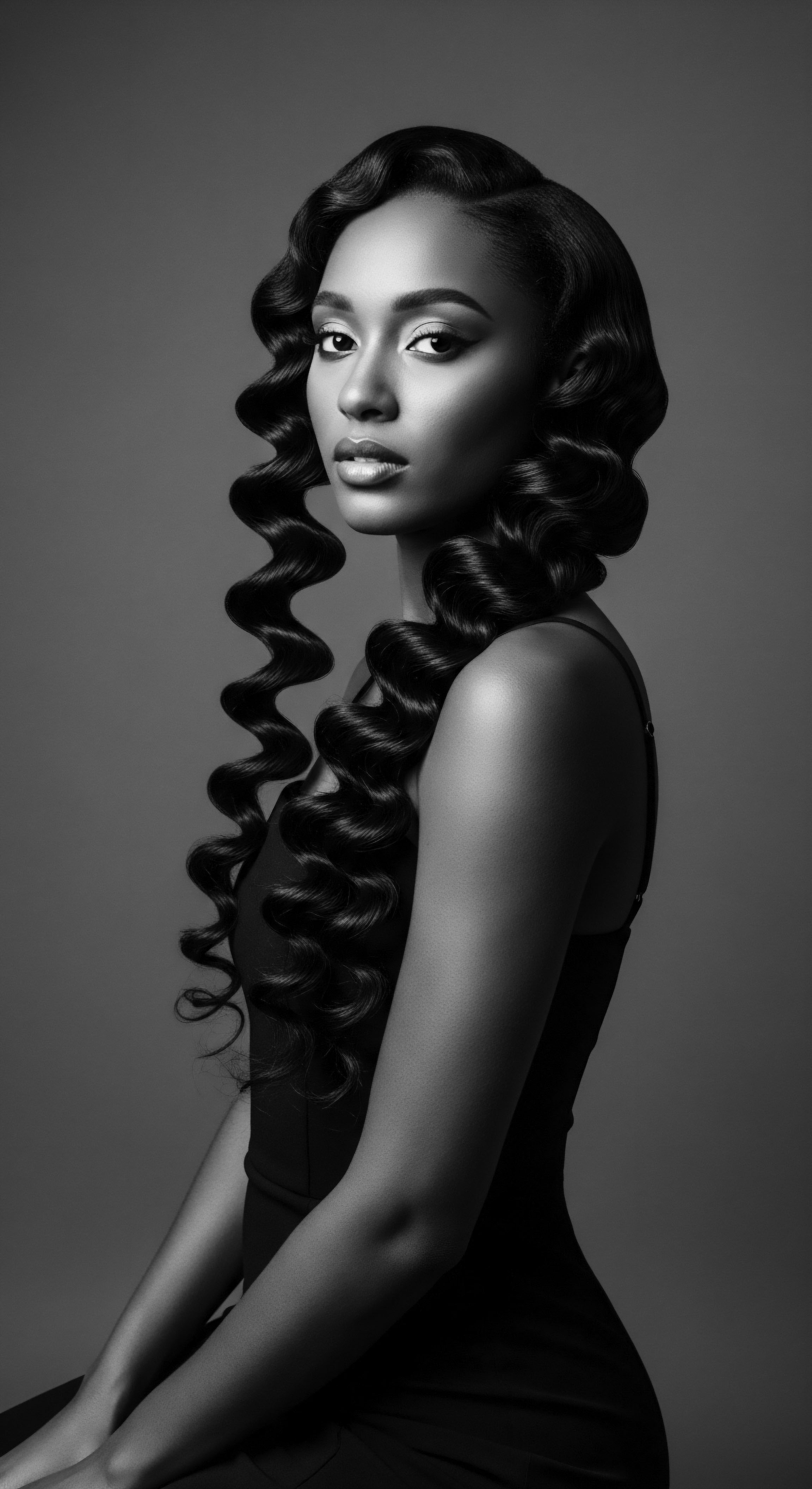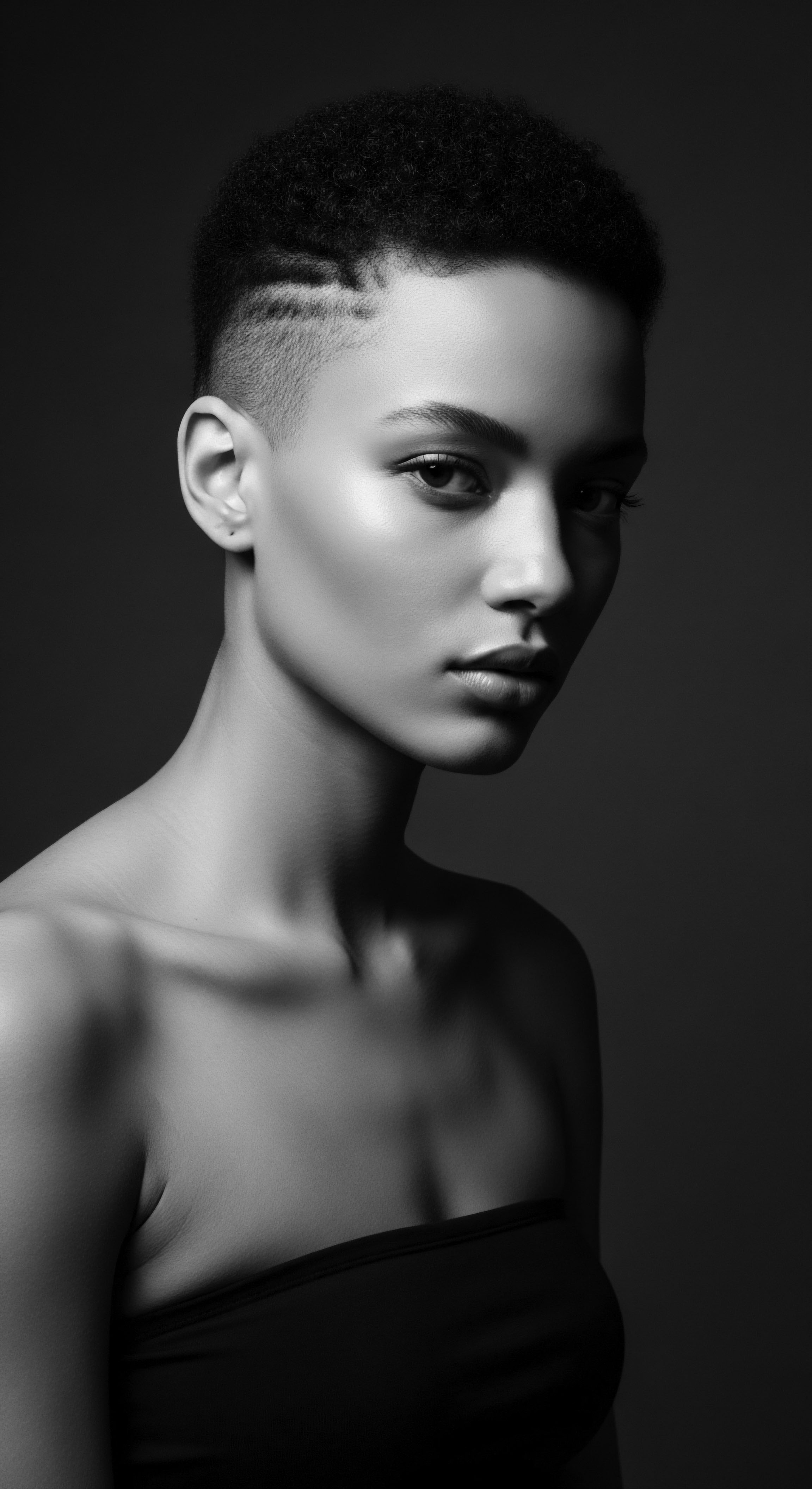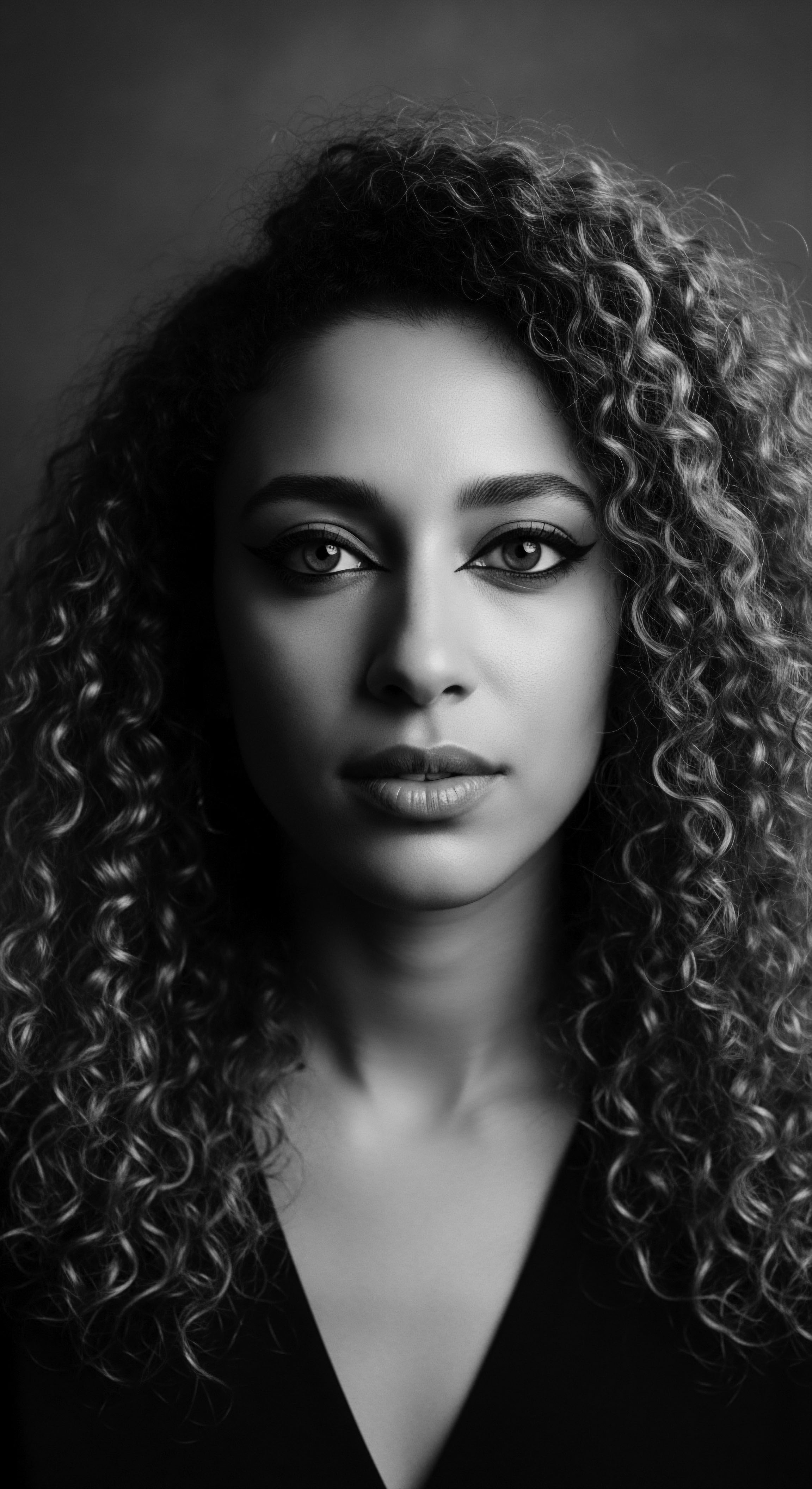
Fundamentals
The true definition of Feminine Power, particularly as it relates to textured hair, extends far beyond simple notions of physical strength or outward adornment. It represents an inherent generative force, a deep wellspring of resilience, intuition, and profound connection that lives within individuals and communities. This power is not a fleeting trend, but a continuous stream of ancestral wisdom, flowing from the very origins of human experience and expressed in the unique helix of textured hair. Its meaning is a profound exploration, an interpretation woven through centuries of cultural practices and shared legacies.
Consider the elemental biology of textured hair, a marvel of natural design. Each strand, with its distinctive curl pattern, serves as a testament to biological precision and aesthetic diversity. The microscopic architecture, a ballet of protein structures and disulfide bonds, allows for the wondrous coiling and coiling that defines Black and mixed-race hair. This physical characteristic, far from being a mere aesthetic detail, acts as a living symbol, a tangible link to ancient practices and the innate vitality of the feminine spirit.
Ancient civilizations in Africa understood this connection profoundly. Their communal lives often centered around practices that honored hair as a conduit for spiritual energy and a direct line to ancestral wisdom.
In these early societies, hair was not a subject for casual consideration; it was a sacred extension of the self, a physical marker of identity, and a profound channel for communication with the divine. The top of the head, crowned by hair, was often revered as the point of spiritual entry. This belief gave rise to intricate and time-honored rituals, where the act of hair care transcended hygiene, becoming a ceremonial dialogue between the living and the ancestral realms. The care bestowed upon hair was a reflection of respect for one’s lineage and an acknowledgment of the inner strength it represented.
Feminine Power, within the context of textured hair, signifies an inherent, enduring capacity for creation, spiritual connection, and community, deeply rooted in ancestral practices.
Communal care, therefore, emerged as a foundational practice, a collective expression of this deeply embedded power. Imagine the hands of kin, carefully detangling, oiling, and styling, sharing stories and wisdom passed down through generations. These gatherings were not simply about grooming; they were vital social opportunities, reinforcing communal bonds and preserving shared cultural memory.
The materials used were often gifts from the earth ❉ rich butters, nourishing oils, and fragrant herbs, each chosen for its restorative and protective properties. This gentle wisdom, passed from elder to child, forged an unbroken chain of knowledge, a testament to the sustaining nature of Feminine Power expressed through the diligent attention given to textured hair.
Beyond its spiritual and communal aspects, hair also served as a visual language within these societies. Different styles conveyed a rich array of information ❉ a person’s age, marital status, social standing, or even their tribal affiliation. The precision required for these intricate styles spoke to a culture of meticulousness and reverence for detail. Hair, in its many forms, acted as a living archive, recording the stories and values of a people.
This profound connection meant that assaults on hair were not merely physical; they were deeply spiritual and cultural affronts, targeting the very essence of a person’s being. The early understanding of Feminine Power, intertwined with the living reality of hair, laid a durable groundwork for generations to follow.

Intermediate
The journey of Feminine Power, expressed through textured hair, took on new layers of meaning as African people were forcibly displaced across continents. Despite the rupture of the transatlantic slave trade, the deep cultural significance of hair persisted, transforming from a marker of identity in homeland communities to a quiet, yet potent, tool of survival and defiance in the diaspora. The collective memory of communal hair practices, passed down through whispers and touch, served as an unseen anchor, helping to preserve a sense of self when all else sought to diminish it. This sustained connection to hair provided an internal space for self-reclamation.
Upon arrival in the Americas, one of the first brutal acts of dehumanization inflicted upon enslaved Africans involved the forced shaving of their heads. This act aimed to strip individuals of their cultural identity, severing the visible connection to their ancestral lands, tribes, and families. It was a deliberate attempt to erase the meanings and significances deeply woven into their hairstyles, reducing them to mere commodities.
Yet, even in this profound act of violence, the spirit of Feminine Power found avenues for persistence. The knowledge of care, the memory of styles, and the inherent connection to hair as a source of strength could not be entirely extinguished.
Hair, despite efforts to erase its meaning during enslavement, became a silent form of resistance and cultural preservation across the diaspora.
In a compelling act of cultural endurance, headwraps, initially imposed by slave masters in some regions as a sign of servitude, were ingeniously re-appropriated by Black women. What began as a badge of supposed inferiority became an emblem of dignity, a vibrant declaration of identity, and a silent form of rebellion. Women crafted these head coverings with luxurious fabrics, vibrant colors, and intricate ties, transforming a symbol of oppression into an expression of personal style and collective defiance. The Tignon Laws in 18th-century Louisiana, for instance, mandated head coverings for Afro-Creole women to distinguish them from white women, but these women responded by adorning their tignons with jewels and elaborate designs, turning an intended mark of subjugation into a statement of elegance and resilience.
Amidst the pervasive hardship, the communal spaces of hair care continued, often in clandestine moments on Sundays or in hushed gatherings. These rituals were far more than simple grooming sessions; they were sacred assemblies where stories were exchanged, ancestral knowledge safeguarded, and a collective sense of belonging reinforced. Women would share scarce ingredients, techniques for protective styling, and whispers of home, all while tending to each other’s crowns.
These moments of shared intimacy, of hands moving through hair, offered psychological refuge and reinforced bonds of sisterhood. The physical act of styling became a powerful reminder of an identity that could not be enslaved, a testament to the sustaining power found in collective nurturing.
- Oral Histories ❉ Passed down through generations, these personal accounts maintained the knowledge of traditional hair practices and their symbolic meanings, despite the absence of written records.
- Secretive Styling Techniques ❉ Enslaved women adapted traditional braids and twists to conceal items like seeds or gold, critical for survival or escape.
- Community Gatherings ❉ Hair care sessions became informal schools, where ancestral methods for hair nourishment and styling, using available natural elements, were taught and reinforced.
The continuity of these practices, often against overwhelming odds, demonstrates a profound manifestation of Feminine Power. It speaks to a deep, unyielding will to preserve heritage, to find beauty and purpose in the face of ugliness, and to maintain connection amidst disconnection. The very act of caring for one’s own hair, or the hair of a loved one, became a quiet yet potent act of self-love and cultural affirmation, securing a legacy for future generations.

Academic
An academic consideration of Feminine Power reveals its deep, immutable roots in human experience, especially within the historical and cultural trajectory of textured hair. This concept delineates an innate capacity for creation, intuitive wisdom, profound resilience, and the fostering of communal solidarity. Within the context of Black and mixed-race hair experiences, Feminine Power emerges as a force that transcends conventional understandings of strength, instead asserting itself through subtle acts of preservation, ingenious forms of resistance, and the enduring affirmation of identity. Its comprehensive meaning is grounded not in dominant societal narratives, but in the embodied knowledge and continuous practices passed down through matriarchal lines and community bonds.
Consider a compelling historical instance that powerfully illustrates this definition ❉ the ingenious use of cornrows as cartographic codes by enslaved women in Colombia. This specific practice stands as a testament to the profound strategic and communicative aspects of Feminine Power, operating under conditions of extreme duress. During the 17th century, as people were forcibly taken from their homelands and subjected to the brutal realities of enslavement in regions like present-day Colombia, the knowledge embedded within hair practices became a lifeline. In a period when literacy was routinely denied to enslaved populations, and any overt acts of resistance were met with severe penalties, cornrows became a covert system for transmitting vital information.
Enslaved women transformed their hair into clandestine maps, demonstrating an extraordinary application of Feminine Power through strategic innovation and cultural preservation.
Enslaved women would meticulously braid patterns into their hair that were not merely decorative. These configurations served as literal maps, guiding fellow captives to freedom. A particular style, known as departes, involved thick, tight braids pulled close to the scalp and often tied into buns on top, signaling plans to escape. Curved braids might denote winding roads or rivers, while straight lines indicated direct paths.
Different arrangements of braids could mark meeting points, delineate safe houses, or even pinpoint sources of water. This practice, primarily preserved through oral histories within Afro-Colombian communities, speaks to an astonishing level of collective intelligence and strategic coordination. The community of Palenque de San Basilio, the first free village in the Americas founded by escaped enslaved people (Maroons) led by King Benkos in the early 17th century, is cited as a place where these coded hairstyles played a role in successful flight.
This sophisticated application of hair as cartography was not a random occurrence. It relied fundamentally on several aspects of textured hair itself. The dense, coily nature of Afro-textured hair allows for intricate braiding patterns to hold their structure for extended periods, making them ideal for concealing information without detection. Furthermore, the communal act of braiding provided a natural, seemingly innocuous setting for the dissemination of this critical knowledge.
Women gathered, hands working rhythmically through hair, sharing insights and plans in a language impenetrable to their captors. This was an act of profound intellectual property, a complex communication system developed and sustained by women, directly using their physical being and inherited cultural practices as instruments of liberation.
| Aspect of Hair Use Cornrows as Maps |
| Historical Context / Purpose Used by enslaved women in Colombia to encrypt escape routes and hide locations, leveraging the hair's ability to hold complex, durable patterns. |
| Aspect of Hair Use Hair as a Repository |
| Historical Context / Purpose Seeds, grains, and even small gold nuggets were braided into hair to aid survival during escape or to start new lives in Maroon communities. |
| Aspect of Hair Use Headwraps as Defiance |
| Historical Context / Purpose Initially forced coverings (e.g. Tignon Laws in Louisiana), re-appropriated through elaborate styling and rich fabrics to assert dignity and identity. |
| Aspect of Hair Use Communal Hair Care |
| Historical Context / Purpose Provided clandestine spaces for sharing ancestral knowledge, nurturing familial bonds, and reinforcing a collective sense of self amidst dehumanization. |
| Aspect of Hair Use These historical uses of textured hair illustrate how ancestral practices were adapted as tools for survival and cultural continuity, embodying Feminine Power in adversity. |
Beyond the practical function of mapping, hair served as a literal and symbolic repository of life itself. Enslaved women secreted grains of rice, seeds, and even small gold nuggets within their elaborate braids. These concealed items were not only provisions for the perilous journey to freedom but also the promise of a future, the foundation for sustenance and economic independence once liberty was attained.
This foresight, this meticulous planning for survival and regeneration, speaks to a deep, inherent Feminine Power—a protective and life-affirming instinct that defies the very structures of oppression. It transformed hair into a vessel of hope, a mobile sanctuary for a future existence.
Furthermore, the spiritual dimension of hair, a belief deeply ingrained in many pre-colonial African societies, persisted throughout the diaspora. Hair was regarded as an “antenna,” a sensitive conductor linking individuals to the spiritual realms, to their ancestors, and to a higher collective consciousness. The careful tending of hair, even in the most dire circumstances, was a sacred ritual—a way to maintain spiritual protection, to invoke ancestral guidance, and to affirm a divine connection that could not be severed by earthly chains. This sustained spiritual anchor provided immense psychological fortitude, serving as a silent declaration of an internal freedom that remained untouched.
The evolution of these practices extended far beyond the immediate era of enslavement. The reclamation of natural hair in the 20th century, particularly during the Civil Rights and Black Power movements, represents a continuation of this enduring Feminine Power. The Afro, cornrows, and other styles became potent political statements, a rejection of Eurocentric beauty standards imposed over centuries, and a re-affirmation of Black identity and aesthetic sovereignty.
This societal shift, often spearheaded by Black women, demonstrated a collective exercise of agency, reshaping narratives around beauty, professionalism, and self-worth. The psychological impact of embracing natural hair cannot be overstated; it contributed to a profound re-alignment of identity, fostering greater self-acceptance and a stronger connection to African heritage.
In conclusion, the academic delineation of Feminine Power, viewed through the lens of textured hair heritage, reveals a complex interplay of physical resilience, intellectual ingenuity, spiritual grounding, and communal solidarity. It is a power that operates not through overt dominance, but through adaptability, covert communication, nurturing, and an unyielding commitment to cultural preservation. This exploration of its meaning highlights the depth of human spirit that transforms tools of oppression into instruments of liberation, creating a profound and enduring legacy for generations.

Reflection on the Heritage of Feminine Power
The journey through the definition of Feminine Power, intrinsically linked to the narrative of textured hair, concludes not with a final period but with an ongoing understanding. It is a testament to the enduring spirit that has coursed through generations of Black and mixed-race communities, a vibrant lifeline connecting the ancient past to our present reality. Each curl, coil, and braid bears witness to a profound history, a living archive of resilience and creativity that no system of oppression could ever fully extinguish. This power, often quiet yet always potent, stands as a beacon.
From the ceremonial practices of pre-colonial Africa, where hair was revered as a sacred conduit for ancestral wisdom, to the clandestine cartography braided into cornrows during the darkest days of enslavement, Feminine Power has continually adapted, finding ways to express itself even in the most constrained environments. The transformation of imposed headwraps into defiant statements of style, or the collective solace found in communal hair-care rituals, each instance underscores an inherent capacity to transmute adversity into expressions of dignity and self-possession. The wisdom in these practices, passed down through the gentle, knowing hands of mothers and grandmothers, speaks of a heritage not merely observed but lived, breathed, and embodied.
Today, this heritage continues to evolve, as new generations reclaim and redefine what it means to wear textured hair with pride. The modern natural hair movement, a global phenomenon, mirrors these ancestral acts of affirmation, celebrating the intrinsic beauty and versatility of Black and mixed-race hair. It is a powerful contemporary echo of the deep historical roots we have explored, affirming that the aesthetic is inextricably linked to identity, and identity to an unbroken lineage of strength. The very act of caring for and celebrating one’s textured hair becomes a deeply personal, yet collectively resonant, act of honoring this enduring Feminine Power.
The “Soul of a Strand” ethos resonates deeply with this understanding. It reminds us that within each individual hair strand resides the collective memory, the whispered secrets, the enduring wisdom, and the vibrant spirit of those who came before. It is a call to recognize that the care given to our hair is not solely cosmetic, but a ritualistic act of connecting to a heritage rich with power, purpose, and profound beauty. This understanding of Feminine Power, therefore, is an ongoing invitation to listen to the silent stories held within our coils, to honor the ancestral practices that sustained us, and to carry forward a legacy that champions authenticity and resilience.

References
- Byrd, Ayana D. and Lori L. Tharps. Hair Story ❉ Untangling the Roots of Black Hair in America. St. Martin’s Press, 2001.
- Fields-Black, Edda L. Deep Roots ❉ Rice Farmers in West Africa and the African Diaspora. Indiana University Press, 2008.
- Griebel, Helen Bradley. “The African American Woman’s Headwrap ❉ Unwinding the Symbols.” Dress, vol. 20, 1993, pp. 5-16.
- Johnson, Audrey M. and Charles R. Bankhead. Black Hair ❉ A Historical and Cultural Perspective. McFarland, 2014.
- Lester, Neal A. Nappy Edges ❉ A Novel. Washington Square Press, 2000.
- Mbilishaka, Afiya M. “PsychoHairapy ❉ Using hair as an entry point into Black women’s spiritual and mental health.” Meridians ❉ Feminism, Race & Transnationalism, vol. 16, no. 2, 2018, pp. 382–392.
- Patton, Sharon F. African-American Art. Oxford University Press, 2006.
- Simon, Diane. Hair ❉ Public, Political, Extremely Personal. Bloomsbury Academic, 2020.
- Thornton, John Kelly. Africa and Africans in the Making of the Atlantic World, 1400-1800. Cambridge University Press, 1998.
- Walker, Alice. In Search of Our Mothers’ Gardens ❉ Womanist Prose. Harcourt Brace Jovanovich, 1983.
